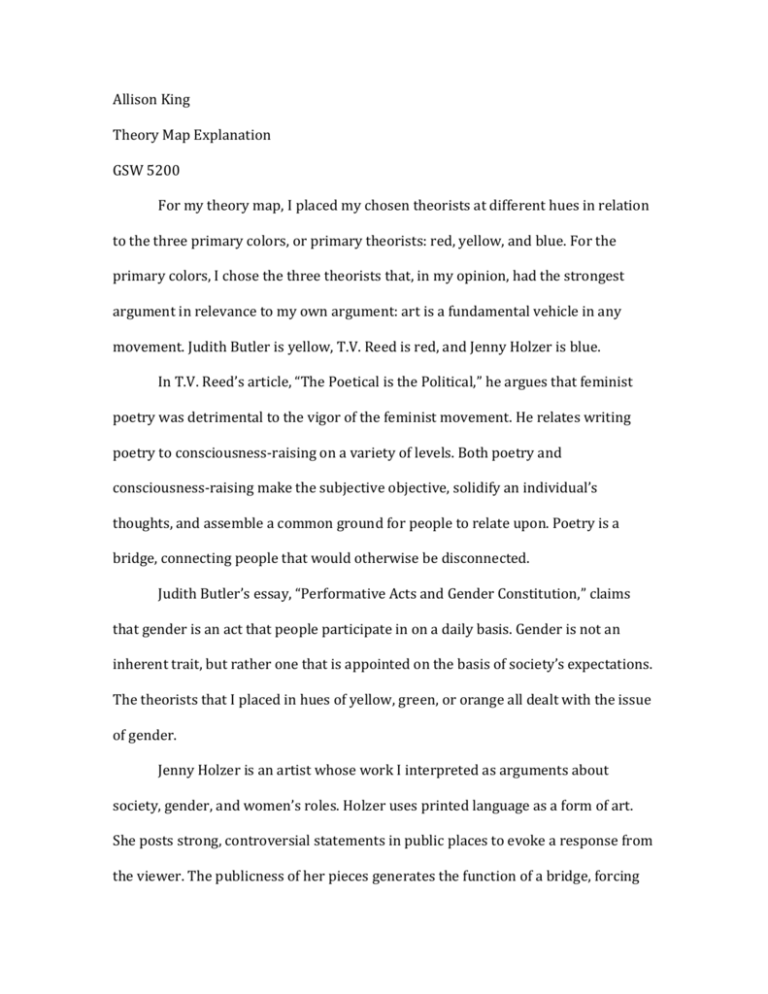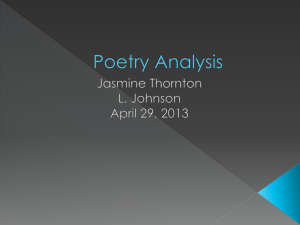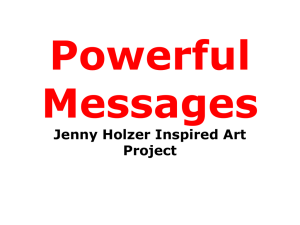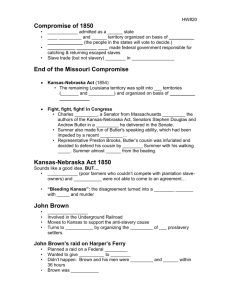Allison King Theory Map Explanation GSW 5200 For my theory map
advertisement

Allison King Theory Map Explanation GSW 5200 For my theory map, I placed my chosen theorists at different hues in relation to the three primary colors, or primary theorists: red, yellow, and blue. For the primary colors, I chose the three theorists that, in my opinion, had the strongest argument in relevance to my own argument: art is a fundamental vehicle in any movement. Judith Butler is yellow, T.V. Reed is red, and Jenny Holzer is blue. In T.V. Reed’s article, “The Poetical is the Political,” he argues that feminist poetry was detrimental to the vigor of the feminist movement. He relates writing poetry to consciousness-raising on a variety of levels. Both poetry and consciousness-raising make the subjective objective, solidify an individual’s thoughts, and assemble a common ground for people to relate upon. Poetry is a bridge, connecting people that would otherwise be disconnected. Judith Butler’s essay, “Performative Acts and Gender Constitution,” claims that gender is an act that people participate in on a daily basis. Gender is not an inherent trait, but rather one that is appointed on the basis of society’s expectations. The theorists that I placed in hues of yellow, green, or orange all dealt with the issue of gender. Jenny Holzer is an artist whose work I interpreted as arguments about society, gender, and women’s roles. Holzer uses printed language as a form of art. She posts strong, controversial statements in public places to evoke a response from the viewer. The publicness of her pieces generates the function of a bridge, forcing people on the street, possibly strangers, to identify with her work and as a result, with each other. Theorists in hues of blue, purple, and green all relate to bridges, gender, sexuality, or emotionality of some sort. I placed Muriel Rukeyser’s poem, “The Poem As Mask,” in the Reed’s red section, but in the lower part, closer to both Butler and Holzer. The poem relates to Reed for obvious reasons; it is a poem, and it is making the poetical political. It relates to Butler because it is arguing that sometimes poetry can be an act, just as gender can be; poetry can be manipulated to evoke any type of façade, just as gender can. Rukeyser relates to Holzer in that they are both forms of art, making a statement about a woman’s identity. Rushin’s “The Bridge Poem” is near Rukeyser, but closer to Holzer and further from Butler. This poem also relates to Reed for obvious reasons, in that it is a poem, creating a voice to be projected into the public. The poem is about a multicultural person being a bridge to people of those particular cultures, which is also a topic that Reed discusses: bridges. “A Black Feminist Statement” by the Combahee River Collective is placed in the middle of Reed and Holzer. I related the essay to Reed because of one of their main themes: consciousness-raising. This essay is the first time that we learned about this idea, which held steady throughout the rest of our semester. Reed and the Combahee River Collective testify that consciousness-raising is integral to any collaboration or advancement. I thought that the essay also related to Holzer because of the consciousness-raising aspect of her work. Holzer’s art does exactly what the essay says about consciousness raising: “…sharing and growing consciousness, to build a politics that will change our lives and inevitably end our oppression” (p. 117). Alison Jaggar is next, in between Holzer and Butler. I related her essay, “Love and Knowledge: Emotion in Feminist Epistemology,” to Holzer because of what she claims about evoking emotional responses. She argues that the more emotional of a response that we have to something, the more value we hold in that thing. Holzer’s work is designed to promote an unexpected, emotional response, which places value into the content of her pieces. Jaggar relates to Butler in that they both take something that is perceived as innate (emotions and gender, respectively) and make the claim that they are controlled human concepts. Suzanna Walters’ “From Here to Queer” is situated just as in between Butler and Holzer as Jaggar, but closer to Reed. I thought Walters’ claims about sexuality, gender as a performance, and consciousness-raising earned her that particular spot. Calhoun’s “Separating Lesbian Theory From Feminist Theory” is near theorists Butler, Jaggar, and Bunch, because it pertains to sexuality and gender. Charlotte Bunch is next, near Calhoun, Walters, Wittig, and Irigaray. Bunch relates to Calhoun and Walters because they are both discussing sexuality and society. Bunch relates to Wittig because they both identify lesbianism as the ideal society. Wittig and Bunch both relate to Irigaray because they both take an extreme stance on our society, saying that men are the problem, and without them, things would be much better. I placed Irigaray closer to Marina Abramovic than the other theorists that I found similar to her (Wittig, Bunch, Walters) because of her focus on a woman discovering her own identity. I think that this relates to some of Abramovic’s work because her pieces are usually her alone. When she performs alone, it shows an individual’s journey, which multiple people can relate to. Irigaray’s essay seemed very personal, but relatable for many women. Abramovic is placed in the middle of Butler and Reed. She is a performance artist, which I thought fit well with Butler’s claims of gender as a performance. Abramovic also deals with issues of gender and society’s expectations of gender and sexuality in a lot of her work. I thought that she related to Reed because of the idea of art as a voice of a movement. Minnie Pratt’s “Identity: Skin, Blood, Heart” had a lot to say about personal identity, crossing over barriers to reach other cultures, and pushing the limits of comfort. I placed her in Reed’s hues because I felt like her explanation of uneasiness and pushing through that uncomfortable feeling related a lot to poetry, or art in general. Art is made to evoke responses, sometimes of uncomfortable feelings. It is in the passing of those uncomfortable feelings that progress is made. I put Pratt closer to Rushin because of the bridge theme. Yosano Akiko’s “The Day the Mountains Move” is placed closest to Reed for the obvious reasons of it being a poem. I placed it near Pratt and Abramovic because of its involvement with women’s identities.









